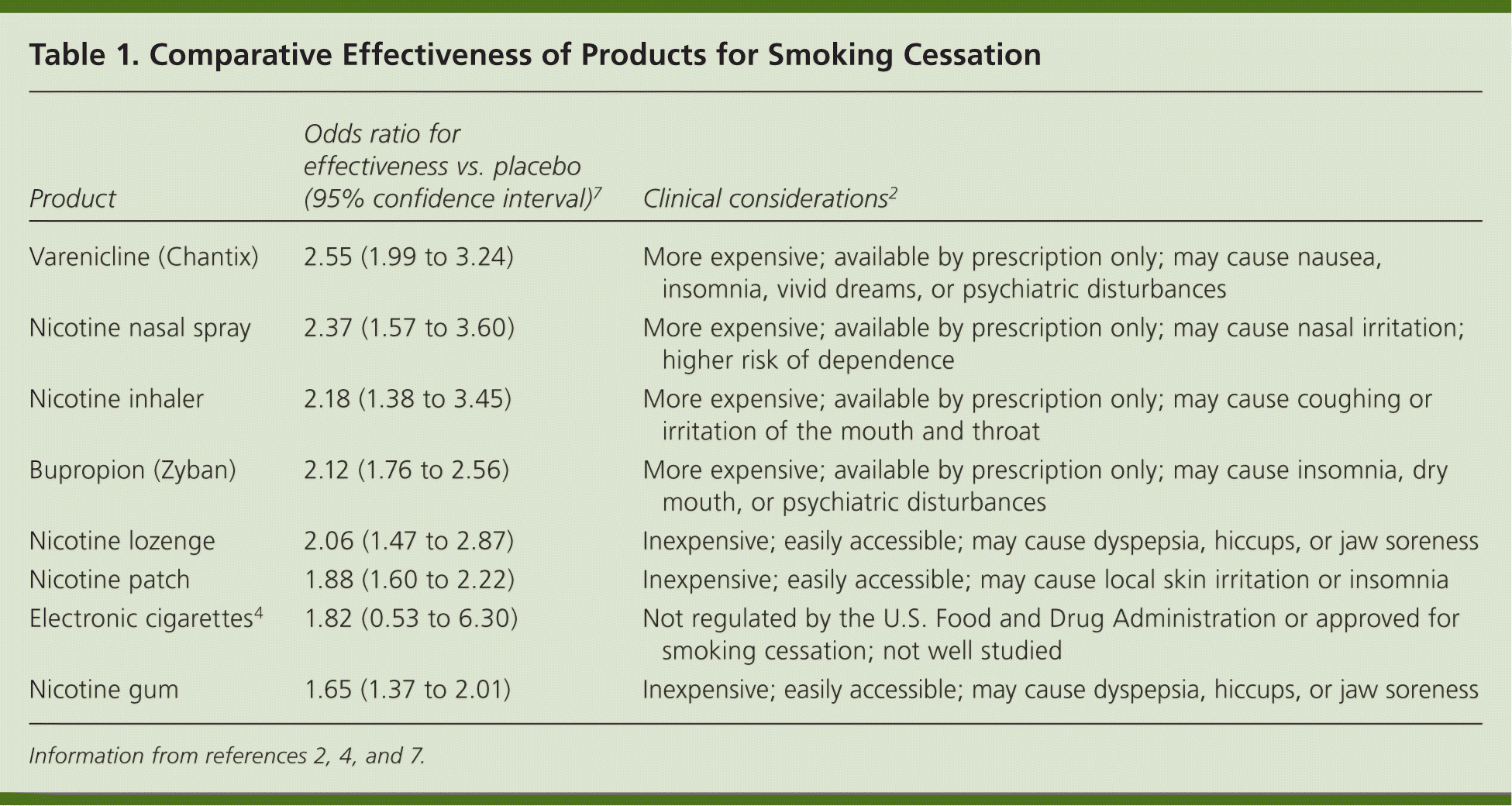
Am Fam Physician. 2014;90(5):282-284
Author disclosure: No relevant financial affiliations.
Cigarette smoking is the leading cause of disease in the United States, and smoking cessation may be one of the most challenging health decisions. Electronic cigarettes, also known as e-cigarettes, are gaining popularity as a novel approach to smoking cessation, but data regarding their safety and effectiveness are lacking. As physicians seek new tools to help their patients stop smoking, they must recognize that a patient's motivation, plan, support, and follow-up are key to success.
E-cigarettes were introduced in the United States in 2007. There are more than 250 brands currently on the market.1 The devices are sold over the Internet and in convenience stores, mall kiosks, and drugstores; they are designed to resemble cigarettes, cigars, pipes, pens, or USB memory sticks.2,3 There are three styles available: a one-piece disposable vaporizer with a nonrefillable nicotine cartridge; a two-piece device with a rechargeable battery and refillable cartridge; and a three-piece kit with a rechargeable battery, nicotine cartridge, and atomizer.2 As air is drawn into the device, an airflow sensor is activated, which in turn activates a heating element in the atomizer to create water vapor that is inhaled.2 E-cigarettes may contain flavors, nicotine, additives, herbal extracts, or vitamin supplements, or may be nicotine-free.2
There is a lack of data on the effectiveness of e-cigarettes for smoking cessation4–6 (Table 12,4,7 ). One of the first prospective randomized controlled trials of e-cigarettes examined whether the devices were more effective than nicotine patches or placebo in regard to six-month smoking abstinence rates in approximately 650 participants.4 It found a trend toward improved abstinence rates compared with nicotine patches (7.3% vs. 5.8%), but the relative risk was not significant (1.26; 95% confidence interval, 0.68 to 2.34). Intensive behavioral support was not provided, which may have affected abstinence rates. Overall, investigators found a lower-than-expected abstinence rate for all methods, which underpowered the study to detect a true difference in abstinence rates. Despite these findings, e-cigarettes seem to be as effective as nicotine patches and may have additional benefits; time to relapse was nearly twice as long in the e-cigarette groups compared with the nicotine patch groups, and participants liked the perceived health benefits, taste, ease of use, and sensory familiarity of e-cigarettes.

| Product | Odds ratio for effectiveness vs. placebo (95% confidence interval)7 | Clinical considerations2 |
|---|---|---|
| Varenicline (Chantix) | 2.55 (1.99 to 3.24) | More expensive; available by prescription only; may cause nausea, insomnia, vivid dreams, or psychiatric disturbances |
| Nicotine nasal spray | 2.37 (1.57 to 3.60) | More expensive; available by prescription only; may cause nasal irritation; higher risk of dependence |
| Nicotine inhaler | 2.18 (1.38 to 3.45) | More expensive; available by prescription only; may cause coughing or irritation of the mouth and throat |
| Bupropion (Zyban) | 2.12 (1.76 to 2.56) | More expensive; available by prescription only; may cause insomnia, dry mouth, or psychiatric disturbances |
| Nicotine lozenge | 2.06 (1.47 to 2.87) | Inexpensive; easily accessible; may cause dyspepsia, hiccups, or jaw soreness |
| Nicotine patch | 1.88 (1.60 to 2.22) | Inexpensive; easily accessible; may cause local skin irritation or insomnia |
| Electronic cigarettes4 | 1.82 (0.53 to 6.30) | Not regulated by the U.S. Food and Drug Administration or approved for smoking cessation; not well studied |
| Nicotine gum | 1.65 (1.37 to 2.01) | Inexpensive; easily accessible; may cause dyspepsia, hiccups, or jaw soreness |
E-cigarettes are marketed as safer alternatives to cigarettes because they do not contain the tar, carcinogens, and other harmful chemicals in tobacco smoke. However, they have been associated with short-term adverse effects (e.g., mouth and throat irritation, cough). In the randomized controlled trial discussed previously, e-cigarettes and nicotine patches had similar rates of adverse effects.4 In a recent study involving short exposure to e-cigarettes (five minutes), an increase in airway resistance and decrease in fraction of exhaled nitric oxide were noted.8 E-cigarettes have the potential for short-term and serious long-term adverse outcomes, and there is an obvious need for long-term safety data.
With the rise of e-cigarette marketing and popularity, concerns have arisen that these products are attracting new and younger smokers. E-cigarettes are promoted as glamorous and safe accessories that can be used long term as tobacco alternatives or short term in places where smoking is banned.9 A survey of middle school and high school students found that the use of e-cigarettes doubled from 2011 to 2012, and that about 9% of those who used the devices reported that they had never smoked conventional cigarettes.10
Federal and state governments' stance on e-cigarettes is evolving. E-cigarettes that are not marketed for therapeutic purposes are not currently regulated by the U.S. Food and Drug Administration (FDA), and most states do not have regulations for their sale to minors.10 The FDA has conducted limited laboratory studies and found significant quality-control issues that indicate substandard manufacturing processes.3 E-cigarettes are currently considered a medical device that does not provide therapeutic benefits.11 However, the FDA intends to create guidelines for e-cigarette regulation under federal rules that will treat them as tobacco products, not medical devices.11 In April 2014, the FDA proposed a new rule that would extend the agency's tobacco authority to cover e-cigarettes. The rule would prohibit sales to minors and require e-cigarette manufacturers to register with the FDA and report product and ingredient listings, among other requirements.12 Throughout the world, countries have either banned e-cigarettes entirely or are beginning to regulate these devices as medications for smoking cessation.13 The American Academy of Family Physicians' policy on e-cigarettes cautions about the lack of oversight and calls for more rigorous research.14
Until there is further research into the benefits and risks of e-cigarettes, physicians should recommend more familiar alternatives to help their patients quit smoking.
